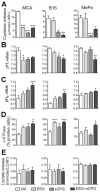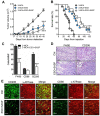Restoring microenvironmental redox and pH homeostasis inhibits neoplastic cell growth and migration: therapeutic efficacy of esomeprazole plus sulfasalazine on 3-MCA-induced sarcoma
- PMID: 28978047
- PMCID: PMC5620187
- DOI: 10.18632/oncotarget.18713
Restoring microenvironmental redox and pH homeostasis inhibits neoplastic cell growth and migration: therapeutic efficacy of esomeprazole plus sulfasalazine on 3-MCA-induced sarcoma
Abstract
Neoplastic cells live in a stressful context and survive thanks to their ability to overcome stress. Thus, tumor cell responses to stress are potential therapeutic targets. We selected two such responses in melanoma and sarcoma cells: the xc- antioxidant system, that opposes oxidative stress, and surface v-ATPases that counteract the low pHi by extruding protons, and targeted them with the xc- blocker sulfasalazine and the proton pump inhibitor esomeprazole. Sulfasalazine inhibited the cystine/cysteine redox cycle and esomeprazole decreased pHi while increasing pHe in tumor cell lines. Although the single treatment with either drug slightly inhibited cell proliferation and motility, the association of sulfasalazine and esomeprazole powerfully decreased sarcoma and melanoma growth and migration. In the 3-methylcholanthrene (3-MCA)-induced sarcoma model, the combined therapy strongly reduced the tumor burden and increased the survival time: notably, 22 % of double-treated mice recovered and survived off therapy. Tumor-associated macrophages (TAM) displaying M2 markers, that abundantly infiltrate sarcoma and melanoma, overexpress xc- and membrane v-ATPases and were drastically decreased in tumors from mice undergone the combined therapy. Thus, the double targeting of tumor cells and macrophages by sulfasalazine and esomeprazole has a double therapeutic effect, as decreasing TAM infiltration deprives tumor cells of a crucial allied. Sulfasalazine and esomeprazole may therefore display unexpected therapeutic values, especially in case of hard-to-treat cancers.
Keywords: 3-methylcholanthrene-induced tumorigenesis; anti-oxidants; proton pump inhibitors; tumor-associated macrophages; xCT.
Conflict of interest statement
CONFLICTS OF INTEREST No potential conflicts of interest were disclosed.
Figures






References
-
- Cerutti PA. Prooxidant states and tumor promotion. Science. 1985;227:375–381. - PubMed
-
- Castellani P, Balza E, Rubartelli A. Inflammation, DAMPs, tumor development, and progression: a vicious circle orchestrated by redox signaling. Antioxid Redox Signal. 2014;20:1086–1097. - PubMed
-
- Ceccarelli J, Delfino L, Zappia E, Castellani P, Borghi M, Ferrini S, Tosetti F, Rubartelli A. The redox state of the lung cancer microenvironment depends on the levels of thioredoxin expressed by tumor cells and affects tumor progression and response to prooxidants. Int J Cancer. 2008;123:1770–1778. - PubMed
-
- Leinonen HM, Kansanen E, Polonen P, Heinaniemi M, Levonen AL. Dysregulation of the Keap1-Nrf2 pathway in cancer. Biochem Soc Trans. 2015;43:645–649. - PubMed
LinkOut - more resources
Full Text Sources
Other Literature Sources

